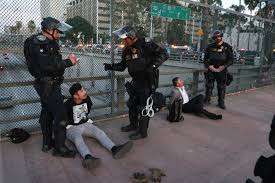Los Angeles mayor lifts curfew imposed in downtown area after immigration raids, protest

Los Angeles Mayor Karen Bass has ended the curfew in downtown L.A. after days of tension following federal immigration raids. The curfew had covered a one-square-mile area, including Civic Center and Little Tokyo. It was originally enforced to control unrest and protect local businesses.
On Tuesday night, Mayor Bass announced that the curfew was no longer necessary. She based her decision on the drop in arrests, vandalism, and street confrontations.
Immigration Raids Spark Citywide Protests
The protests started on June 6, when ICE agents conducted raids across the city. They arrested dozens of undocumented immigrants. Many witnesses said ICE officers took people from their homes and workplaces without showing proper warrants.
Immigrant rights groups quickly organized rallies in response. Protesters demanded the release of detainees and called for stronger protections for immigrant communities. Downtown L.A. soon became the center of the demonstrations.
Mayor Responds With Overnight Curfew
By June 10, the protests had turned more intense. Some people broke windows, looted stores, and clashed with police. In response, Mayor Bass imposed an overnight curfew from 8 p.m. to 6 a.m.
Law enforcement made over 575 arrests, mostly for unlawful assembly and vandalism. While many protests remained peaceful, officials said some individuals used the events to cause damage.
“We support peaceful protest, but we won’t allow violence and looting,” Mayor Bass stated at a press briefing.
Community Criticizes City’s Response
Several community leaders criticized the curfew and the police response. Maria Alvarez, spokesperson for the Coalition for Human Rights in Los Angeles, said the curfew unfairly targeted people of color and unhoused residents.
She called it “an overreach that punished entire neighborhoods for the actions of a few.”
Some city council members also voiced concern. They urged the mayor to end the curfew, especially as tensions eased and demonstrations became more peaceful.
Lawmakers Visit Detention Center, Call Out Conditions
California lawmakers visited the Adelanto ICE Processing Center, where many detainees were held. They reported serious health and safety issues inside the facility.
Congresswoman Linda Sánchez described crowded rooms, poor hygiene, and a lack of clean clothes. She called for an investigation into the detention center and criticized ICE for violating basic human rights.
“These are not criminals. They are people trying to live and work. We must treat them with dignity,” she said.
Mayor Lifts Curfew, But Remains Cautious
On June 17, Mayor Bass officially lifted the curfew. She said the city had seen a significant drop in violence and property damage. The mayor thanked law enforcement, community mediators, and residents for their role in restoring calm.
“We are returning to normal,” she said. “But if things escalate again, I won’t hesitate to act.”
The mayor also said she would hold meetings with federal officials and local leaders to discuss immigration policy and public safety.
Businesses Start Reopening After a Difficult Week
With the curfew lifted, businesses in the downtown area have begun reopening. Many owners, however, remain cautious.
Tony Yang, who runs a café near Grand Park, said the past week was tough. “We had to close early every night. Customers stayed away. I hope things stabilize now,” he said.
The city plans to support affected businesses with small grants and help with insurance claims.
Advocates Plan More Marches, Push for Sanctuary Policies
Although the curfew has ended, protests are likely to continue. Advocacy groups are planning a march this weekend to demand stronger sanctuary laws and accountability for ICE actions.
Organizers say the movement is growing. They want California to push back harder against federal immigration enforcement.
Mayor Bass expressed support for peaceful demonstrations. She said she remains committed to protecting immigrant families and upholding human rights in Los Angeles.
Conclusion
The end of the downtown curfew signals a moment of relief for Los Angeles. But the larger debate around immigration enforcement and civil liberties remains unresolved. City officials, community leaders, and residents must now work together to find a lasting solution.






